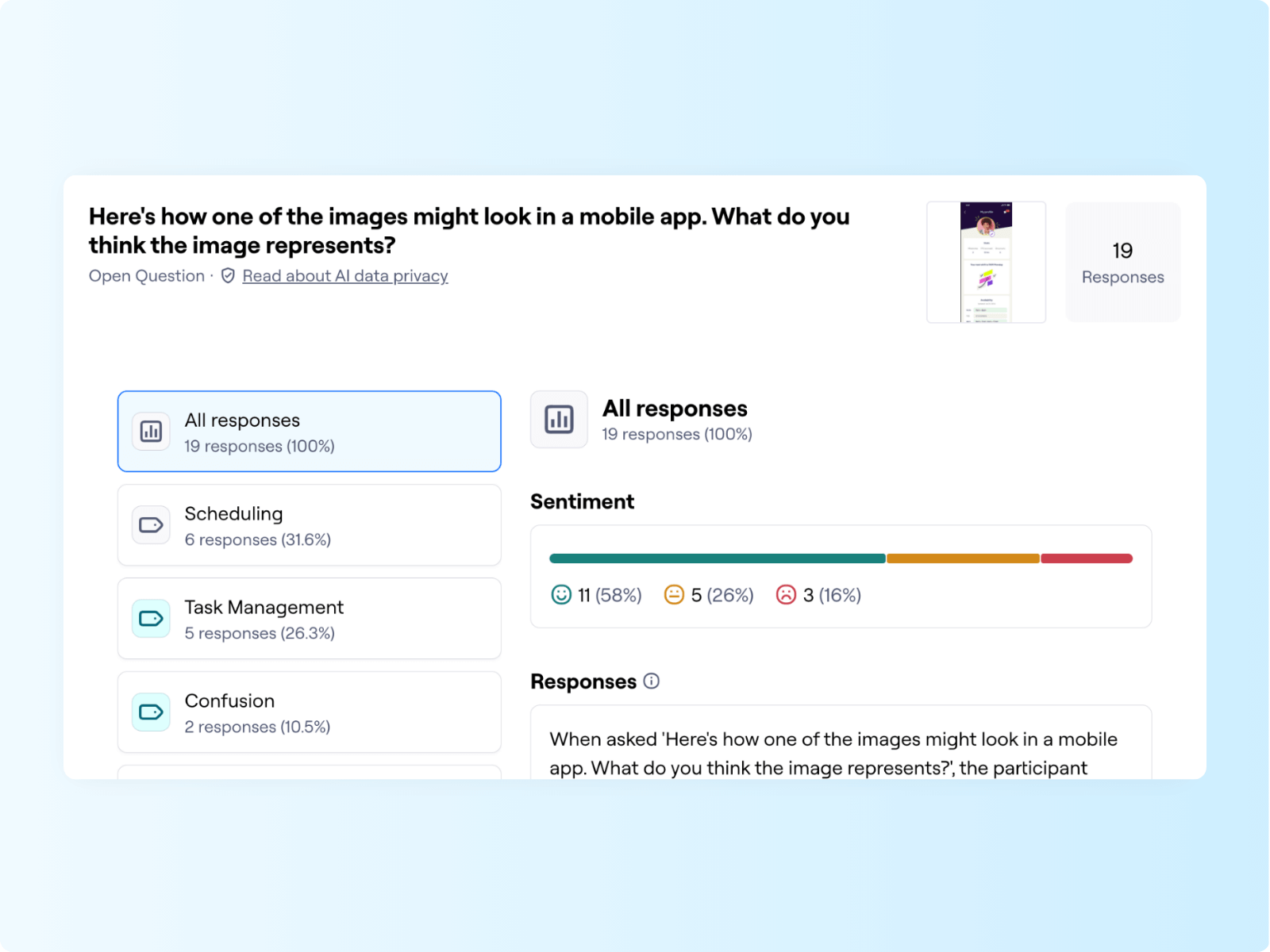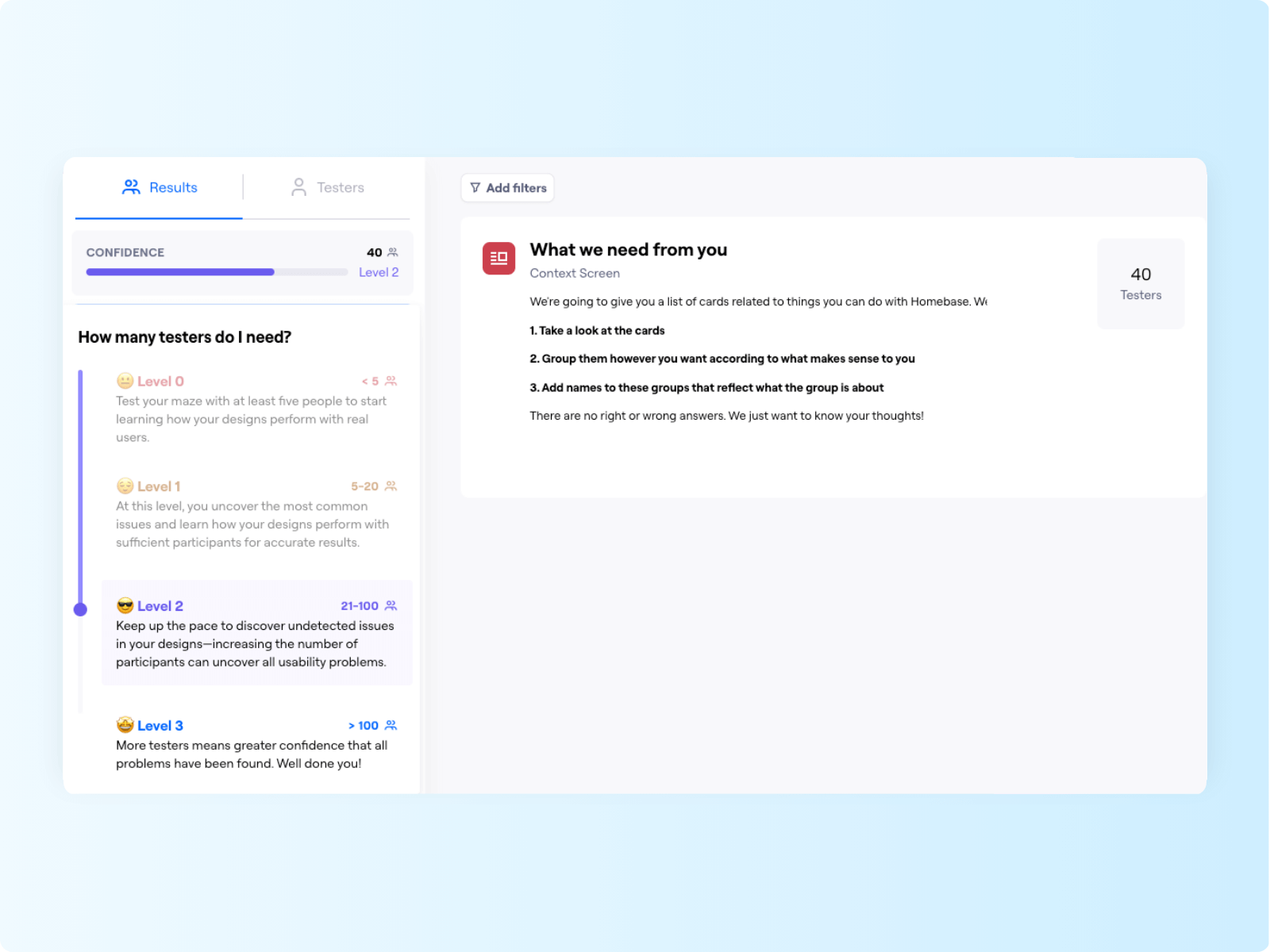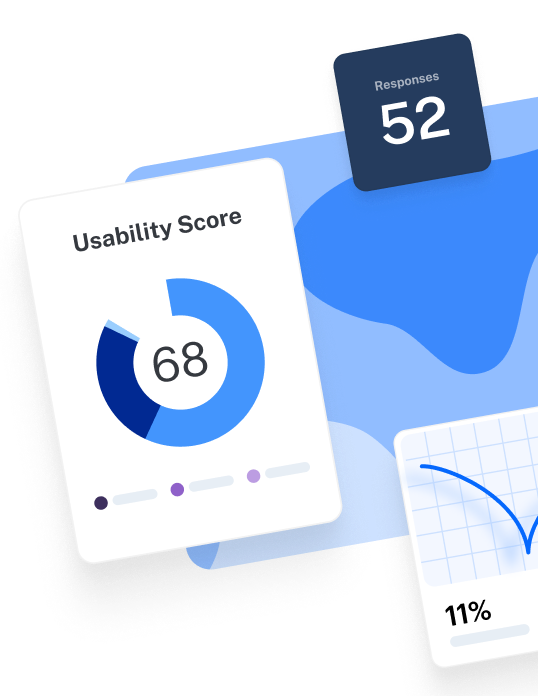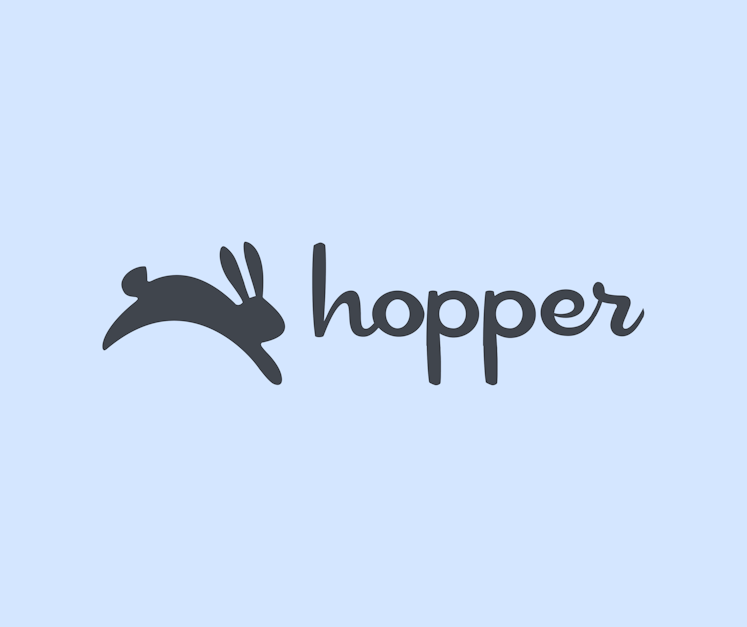

How Homebase enriched its research practice by moving to Maze
Learn why Homebase switched to Maze, and how they’re using it to transform their data quality and research practice.
About Homebase
Homebase is a team management app for small businesses to simplify scheduling, time clocks, payroll, and HR.
Industry
Tech & Software
Opportunity
Improve their research process and workflows, capture higher quality data, and share insights more quickly and easily.
Key Maze features used
Reach
Automated Reporting
Card Sorting
Maze AI
Surveys
Share
Built for small businesses like local restaurants, shops, and services, Homebase is a team management application that simplifies scheduling, time clocks, payroll, team communications, and HR for over 100,000 businesses and 2 million workers.
As the design and research team at Homebase grew 5x over the past eighteen months, their existing solution was hindering their ability to scale research, collaborate on studies, gather quality data, and generate insights quickly.
Janet Taylor, Senior Director of Product Design and Research at Homebase, saw the opportunity to improve their UX research processes and workflows, capture richer data from users, generate insights more easily, and scale findings faster.
The growing limitations of existing tools
As a highly customer-centric company, user research is deeply infused within the Homebase culture. Designers, product managers, and product marketing managers all conduct their own research. Designers are even required to have a certain number of customer contact hours per month “as a performance metric that we track,” says Janet.
But as the design and research team grew, they felt increasingly constrained by their existing research tools. Limited user access made it challenging for the team to run research efficiently, and hard to collaborate effectively or scale research. “It took a lot of internal negotiation and navigation about who could access the tools when,” says Janet, “and it created a lot of mental clutter.”
In addition, not having a centralized UX research platform meant the Homebase team was using “a giant collection of data collection and research tools,” says Janet. “As the team grew, it led to incredible chaos and a lack of quality across the board.” It was also hard to coordinate the activities of a growing team or keep track of who had recently engaged with research activities.

Optimizing UX research practices and workflows with Maze
Maze allows us to consolidate our research in one place and make it visible for everyone. I’m optimistic that Maze will help keep things more centralized and help us work better together as a team.

Janet Taylor
Senior Director of Product Design and Research at Homebase
After exploring other UX research tools, Janet selected Maze as the ideal UX research platform for Homebase. Three key elements played into the decision:
- Holistic, end-to-end functionality
- Modern design and user intuitiveness
- Advanced insights and reporting capabilities
One of the deciding factors was Reach, a feature that makes it easy to build and manage a centralized database of research participants. “What was really exciting to me about Maze was the Reach participant database and the fact that it can operate as a CRM,” says Janet. With Reach, Homebase can keep their customers organized in one place and have visibility into the studies that have been sent out.
Another differentiating factor was the ability to run mixed methods studies with Maze, to gather both qualitative and quantitative data all in one platform. Janet sees this approach as being more intuitive, similar to how a researcher might conduct a study in real life. "I love that Maze lets us use mixed methods in one study. For example, a prototype test and a card sort as part of the same study is absolutely brilliant," says Janet.
The way Maze operates really speaks to the way research is done today and matches the way I think about research.
Janet Taylor
Senior Director of Product Design and Research at Homebase
Maze’s modern interface provides an intuitive experience for the Homebase team, making it seamless to run research. In addition, Janet finds Maze provides a better user experience for their study participants as well—which makes it more likely they’ll respond and engage meaningfully in the study: “We can send a link or launch a test from within the Homebase product. Our customers are very busy, but if they’re already in the product, that’s a great way to ask them to participate in a study without interrupting their workflow too much. Our old research platform required our customers to create an account—which added another step and was a barrier to them using the tool. With Maze, I love that there’s no extra step for our users."
Generating reports is also much easier with Maze. “Creating the research report is always the most laborious task at the end of a study,” says Janet, since it requires painstaking data analysis to uncover patterns and synthesize insights. That’s why she’s delighted by the way Maze automates the process—surfacing themes and insights using AI—and generating reports that can be edited and shared with stakeholders. It’s a huge change from the more labor-intensive process they had before, and allows the team to focus on the most important elements of the work—sensemaking and translating insights into action.
"With the old tool, the reporting was very challenging and cumbersome. We had to manually go through the transcripts, pull out clips, store them in Google Drive, and add them to reports and presentations. But with Maze, the reporting functionality and AI theming really stand out. I love the ability to generate the report automatically, edit it as necessary, and share it out," says Janet.

Putting Maze into action for cross-functional studies
One example of how Maze transformed research for the Homebase team is when they were exploring ways for small businesses to offer benefits to their hourly workers. A Homebase product manager was able to launch a research study quickly and autonomously, using a ranked card sort to understand what kinds of benefits their customers deemed most important to offer, and a survey to determine what they would expect to pay.
Launching the study on Maze was extremely fast and easy. We sent it to our Reach panel and gathered around 300 responses in less than two days.

Janet Taylor
Senior Director of Product Design and Research at Homebase
For the willingness-to-pay survey, the team turned to Maze templates to save time on survey design and generate pre-made UX survey questions. “So we asked: What price would be so low that you would question the quality? What would be an acceptable price? And what price would be too high?”
The best part is how easily and efficiently the survey yielded the exact data the product manager needed, which was phenomenal. “I really liked that we got numerical answers specifically, because we could export the data into a spreadsheet, run some calculations, and boom! We have our number. I was very impressed,” said Janet.
Improving content design with higher quality data
With Maze, the data was incredibly easy to understand and parse because it was presented visually.

Janet Taylor
Senior Director of Product Design and Research at Homebase
By switching to Maze, Janet’s team can now capture and visualize data more effectively, so the insights can be understood and actioned more easily. In one instance, a Homebase content designer performed exploratory work around the settings experience in their product by launching a study with card sorting and tree testing. She wanted to understand the mental models of how customers think about how different settings should be grouped and the navigation around where these settings live.
From determining the research method to recruiting participants, conducting the study, analyzing results, and sharing the data, she was able to swiftly collect high-quality user data, all within Maze.
In contrast to their previous research platform, the team was surprised by how easy it was to collect and synthesize the data, thanks to Maze’s visually-rich data reports. “I’ve run card sorting on other tools, but setting it up was clunky. Looking at the data was also challenging: understanding trends and how users were thinking. There were no visuals; it was all very text-based. In contrast, with Maze, the data was incredibly easy to understand and parse because it was presented visually,” says Janet.
Increasing research enablement with Maze
I want my team to think about research rigor, quality, and best practices, and how their research findings impact the product and the product roadmap. I think a modern tool like Maze is the one to help us do that.

Janet Taylor
Senior Director of Product Design and Research at Homebase
Looking ahead, Janet sees Maze as an ongoing partner to increase research enablement across the organization so designers, product managers, and product marketing managers can all carry out research more autonomously—while still maintaining a consistent standard of “what good research looks like,” says Janet.
A big part of what Maze does is to educate and enable teams by providing tailored onboarding, guides, playbooks, best practices, and support materials, so Maze is excited to play an important role in supporting Homebase’s customer-centered ethos and research-led culture.
I’m really excited for the future of Maze—in terms of where Maze is going to go as a tool, but also what it’s going to do for us at Homebase.

Janet Taylor
Senior Director of Product Design and Research at Homebase







